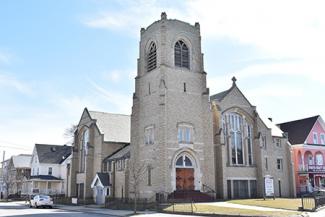A TRULY HISTORIC NOMINATION: Providence Church Listed in National Register in English and Spanish
Published on Monday, March 29, 2021
(Providence, R.I.) J. Paul Loether, Executive Director of the Rhode Island Historical Preservation & Heritage Commission, announced that the National Park Service has added the former Plymouth Congregational Church, home to Iglesia Visión Evangélica since 2016, to the National Register of Historic Places. The National Register is the Federal Government’s official list of properties throughout the United States whose historical and architectural significance makes them worthy of preservation. Constructed between 1915 and 1919 at the corner of Broad Street and Pennsylvania Avenue in Providence, the former Plymouth Congregational Church is significant as a fine example of a late English Gothic Revival-style church. And this nomination itself is significant because it is the first bilingual National Register nomination ever submitted to the National Park Service.
The effort to nominate the former Plymouth Congregational Church to the National Register was initiated by leaders of Iglesia Visión Evangélica, who wanted formal recognition of the building’s historical significance. The City of Providence, understanding the church’s importance to the Broad Street neighborhood, was immediately supportive and secured a Certified Local Government grant from the RIHPHC to fund the nomination. The documentation was prepared by Virginia Adams, Tracy Jonsson, and Elizabeth Totten of PAL. While the National Park Service doesn't yet have a Spanish-language form, the complete nomination includes Spanish-language narratives for the architectural description and statement of significance, translated by City staff, to make the information as accessible as possible to Iglesia Visión Evangélica’s bilingual congregation. The nomination is available on the RIHPHC website, www.preservation.ri.gov.
The former Plymouth Congregational Church is a late English Gothic Revival-style church constructed in 1915-1919 to designs by architect George F. Newton of Boston. It has exterior walls of buff brick with limestone trim, a slate-shingled roof, and a square-plan entrance tower. Most of the pointed-arch window groupings are filled with leaded, diamond-pane glass, while those on the south elevation contain decorative stained-glass designed by Hiemer & Co. and installed in 1944. Almost all of the original window sash survive.
The historic floor plan includes a raised chancel, choir area, organ chamber, and a 400-seat auditorium. Oak pews are laid out in an arcing pattern, beneath Gothic Revival-style hanging light fixtures. The west end of the building was dedicated to the Sunday School, with an assembly area that could be opened to the auditorium via a set of sliding glass doors, and a series of smaller classrooms to its west end. This arrangement, known as the Akron Plan, allowed students to hear the beginning of the service and then attend classes. The auditorium and Sunday School area are spanned by a trussed ceiling of pine stained to resemble oak.
Plymouth Congregational Church was established in 1878, operating out of a converted residence on Prairie Avenue. In 1880-81, the congregation built a church on Richardson Street (now Pennsylvania Avenue). In 1891, with a growing membership and Sunday School, the congregation purchased the lot at the corner of Broad Street and Pennsylvania Avenue. Planning for a new church building began soon after, but was hampered by ongoing financial difficulties. By the time ground was broken in May 1915, the congregation was working off a design by architect George F. Newton of Boston. The new church building was dedicated in March 1919.
In 1927, Plymouth Congregational Church merged with Union Congregational Church, resulting in one of the largest Protestant churches in the city, with nearly 1,200 members. In the ensuing decades, however, many church members moved to the suburbs. By 1968, the number of active members had fallen to about 140. Three years later, the congregation sold the building to an African American congregation, the Holy Cross Church of God in Christ. Iglesia Visión Evangélica acquired the property in 2016.
RIHPHC’s Executive Director J. Paul Loether commented, “The former Plymouth Congregational Church has been a Broad Street landmark for over 100 years, cared for by three congregations over the course of its history. The RIHPHC was thrilled to work with the City of Providence and Iglesia Visión Evangélica, current stewards of the building, to nominate the church to the National Register.”
In addition to honoring a property for its contribution to local, state, or national history, listing on the National Register provides additional benefits. It results in special consideration during the planning of Federal or federally assisted projects and makes properties eligible for Federal and Rhode Island tax benefits for historic rehabilitation projects. Owners of private property listed on the National Register are free to maintain, manage, or dispose of their property as they choose. As the state office for historic preservation, the RIHPHC is responsible for reviewing and submitting Rhode Island nominations to the National Register.
